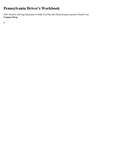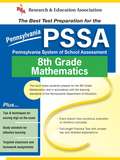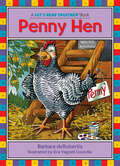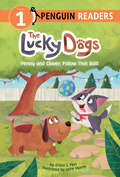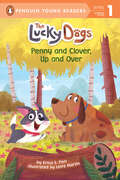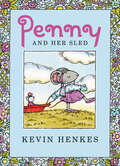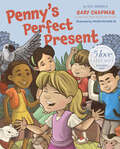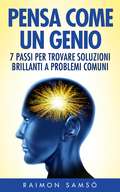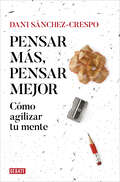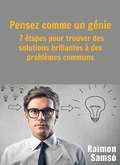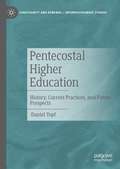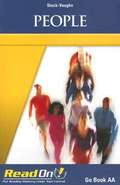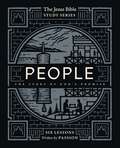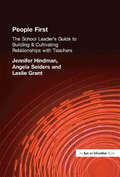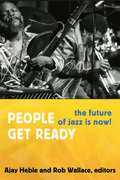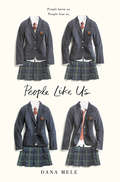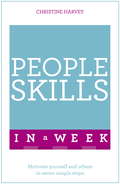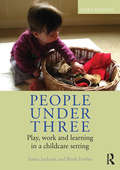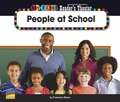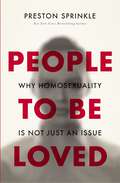- Table View
- List View
Pennsylvania Driver's Manual
by Pennsylvania Department of TransportationPennsylvania Driver's Manual
Pennsylvania Driver's Workbook: 320+ Practice Driving Questions to Help You Pass the Pennsylvania Learner's Permit Test
by Connect PrepTaking the Pennsylvania Learner's Permit Test? Ace It Without Any Problems With the Help of This Pennsylvania Driver's Workbook. The driving exam features a variety of questions that will gauge your quick-thinking skills and require you to use common sense. The questions featured in this book will help you understand what to expect come test-time and increase your chances of earning your learner's permit.
Pennsylvania PSSA Grade 8 Math (Pennsylvania Pssa Test Preparation Ser.)
by Stephen HearneREA ... Real review, Real practice, Real results. REA's Pennsylvania Grade 8 PSSA Math Study Guide! Fully aligned with Pennsylvania's Core Curriculum Standards Are you prepared to excel on this state high-stakes assessment exam? * Take the diagnostic Pretest and find out what you know and what you should know * Use REA's advice and tips to ready yourself for proper study and practice Sharpen your knowledge and skills * The book's full subject review refreshes knowledge and covers all topics on the official exam and includes numerous examples, diagrams, and charts to illustrate and reinforce key math lessons * Smart and friendly lessons reinforce necessary skills * Key tutorials enhance specific abilities needed on the test * Targeted drills increase comprehension and help organize study * Color icons and graphics highlight important concepts and tasks Practice for real * Create the closest experience to test-day conditions with a full-length practice Posttest * Chart your progress with detailed explanations of each answer * Boost confidence with test-taking strategies and focused drills Ideal for Classroom, Family, or Solo Test Preparation! REA has helped generations of students study smart and excel on the important tests. REA's study guides for state-required exams are teacher-recommended and written by experts who have mastered the test.
Penny Hen: Short Vowel E (Let's Read Together ®)
by Barbara deRubertisLet&’s Read Together books merge rhyme and vowel sounds in delightfully zany stories kids will want to read again and again. Each of the 15 books in this classic series by award-winning author/educator Barbara deRubertis will give your child a jumpstart on reading success."Story lines are silly and inventive, and recall Dr. Seuss&’s Cat in the Hat for the building of rhythm and rhyming words." —School Library JournalPenny Hen is a bit upset when she learns she won't be Jenny's only pet! (This easy-to-read story features the short &“e&” vowel sound.)
Penny and Clover, Follow That Ball! (The Lucky Dogs)
by Erica S. PerlLearning to read doesn't need to be ruff with this rhyming tail about a pair of lovable pups, now with a fresh look!Penny and Clover are playing with a ball. They chase it as it bounces all over their backyard, bounding in every direction. But when they go to retrieve it once more, they're surprised to find a new friend at the same time!
Penny and Clover, Up and Over! (The Lucky Dogs)
by Erica S. PerlLearning to read doesn't need to be ruff with this rhyming tail about a pair of lovable pups!Penny is a small, frisky puppy. Clover is a big, careful canine. While Penny has no problem jumping over a log, Clover isn't so sure she can do it. Can Clover come up with the courage to take a leap of faith and follow her friend?
Penny and Her Sled (I Can Read Book: Level 1 Ser.)
by Kevin Henkes“A gentle story of patience.”—Horn Book (starred review)Caldecott Medal–winner Kevin Henkes’s award-winning and bestselling mouse, Penny, stars in an irresistible story about anticipation, disappointment, and a brand-new sled. Told in five short chapters, Penny and Her Sled is perfect for reading alone, reading aloud, and sharing together.When Penny, a sweet and curious mouse, gets a new sled, she can’t wait to use it. But there’s one big problem—there’s no snow!Patiently, Penny waits and watches for the snow to appear. She puts on her scarf and hat. She sleeps with her mittens. Maybe if she’s ready, the snow will finally come. But day after day, the snow does not arrive. Finally, Penny decides she will use her sled for other things—it’s too wonderful not to!With a little imagination, the sled becomes a bridge for her glass animals to cross. It becomes a bed for her doll, Rose. It becomes a magic carpet that takes Penny and Rose on adventures all around the world.And as Penny waits for a snowfall that may never appear, she learns all about the power of patience, imagination, play . . . and spring! Told in five short chapters, and with an emphasis on family and patience, Penny and Her Sled is the perfect choice for emergent readers and for family sharing.
Penny's Perfect Present
by Gary Chapman Rick OsborneA fun book for kids that teaches the secret to relationships In Penny&’s Perfect Present, Penny struggles to feel loved amid all the hustle and bustle around her. She just wants to spend time with her loved ones, but everyone is so busy. Will the trip mom and dad have planned lift her spirits? Join Penny and her friends as they take a visit to the Pet Pal Emporium, a magical place with exotic animals and exciting exhibits. There the owner, Dr. Chapman, creatively teaches the kids about God&’s ever-present love, plus practical ways to show love to others. With a positive message, fun pictures, and animals for children to search out on the page, Penny&’s Perfect Present is a great tool for parents who want to entertain their children while forming confidence and virtue in them.
Penny's Perfect Present
by Gary Chapman Rick OsborneA fun book for kids that teaches the secret to relationships In Penny&’s Perfect Present, Penny struggles to feel loved amid all the hustle and bustle around her. She just wants to spend time with her loved ones, but everyone is so busy. Will the trip mom and dad have planned lift her spirits? Join Penny and her friends as they take a visit to the Pet Pal Emporium, a magical place with exotic animals and exciting exhibits. There the owner, Dr. Chapman, creatively teaches the kids about God&’s ever-present love, plus practical ways to show love to others. With a positive message, fun pictures, and animals for children to search out on the page, Penny&’s Perfect Present is a great tool for parents who want to entertain their children while forming confidence and virtue in them.
Pensa Come Un Genio: 7 Passi Per Trovare Soluzioni Brillanti A Problemi Comuni
by Raimon SamsóIl problema nel suo complesso può essere risolto con un cambio della mentalità che lo ha creato. Ciò è possibile mediante la trasformazione del dialogo interiore- del modo di parlarCi- che finirà col rispecchiarti nella nuova realtà.Dato che le esperienze si adattano ai pensieri, con questo ebook imparerai a identificare la legge dell'attrazione, visualizzare, eliminare i pensieri negativi, per disattivarli mediante 3 semplici domande: come essere più creativi ed avere buone idee anche gli affari, come applicare ai tuoi problemi la legge dell'attrazione, imparare a usare la visualizzazione per generare idee innovative, un metodo di self-coaching personale.Questa lettura genera cambiamenti personali che inducono a creare nuove realtà, sperimentare la pace interiore, recuperare il potere personale e, in definitiva, avanzare verso il successo.Contenuto: "Le 7 azioni, il segreto per creare nuove realtà".1. Inventa il tuo domani con le esperienza di oggi2. Crea lo spazio mentale per una nuova realtà3.Cambia la tua percezione perchè cambi la tua esperienza4. Rinnova il tuo dialogo interiore5. Eleva la vibrazione delle tue affermazioni e convinzioni6. Semina i tuoi pensieri e illumina il tuo successo personale7. Immagina il tipo di vita che desideri per te adessoSe alcune esperienze si ripetono o se senti la tua vita bloccata per certi aspetti, questo libro ti aiuterà a identificare i tuoi limiti mentali e ti porterà a correggerli per raggiungere la pace e la soddisfazione interiore desiderate.
Pensar más, pensar mejor: Cómo agilizar tu mente
by Dani Sánchez-Crespo¿Se puede aprender a ser más inteligente? El director del estudio de videojuegos creador de la saga Invizimals revela estrategias y técnicas para saber pensar bien. Tras veinte años como docente universitario y una amplia experiencia en empresas de innovación tecnológica, Dani Sánchez-Crespo despliegaen este libro todo un arsenal de técnicas que la gente aparentemente inteligente usa a veces de forma consciente, otras inconsciente, para desarrollar todo su potencial creativo. Para ello, parte de una idea provocadora: antes del descubrimiento de la química, la gente creía en la alquimia, una ciencia oscura. ¿Qué pasaría si la inteligencia fuese similar, una ciencia que se puede aprender mecánicamente a la que hemos consideradoun talento tan solo porque aún no se ha estructurado? ¿Y si el ingenio no fuera más que un cúmulo de sencillas herramientas? Pensar más, pensar mejor explica de manera sencilla y divertida todo tipo de técnicas para razonar de forma efectiva: generar más ideas, filtrarlas, explicarlas adecuadamente, resolver problemas de manera eficaz y no encontrar dificultades para discernir la verdad de la mentira.Con un tono desenfadado y optimista, a medio camino entre un manual y unas memorias de éxitos (y fracasos) vitales, el autor revela una auténtica enciclopedia de sistemas de pensamiento. Al terminar la última página, usted será más inteligente. ¿Acaso lo duda?
Pensez comme un génie: 7 étapes pour trouver des solutions brillantes à des problèmes communs
by Raimon Samsó Chimène ElessaEn une heure, vous découvrirez « Les 7 actions » pour penser comme un génie Tout problème peut être résolu en changeant la mentalité qui l'a « créé ». Ceci est possible grâce à la transformation du dialogue intérieur (la façon dont on se parle) et qui finira par se refléter sur notre nouvelle réalité. Puisque les expériences s'adaptent aux pensées, grâce à ce livre, vous apprendrez à identifier, appliquer la loi de l'attraction, visualiser et éliminer les « pensées négatives automatiques » pour, ensuite, les désactiver au moyen de trois questions simples. Dans ce livre : comment avoir plus de créativité et de bonnes idées, y compris en affaires ; comment appliquer la loi de l'attraction (le secret) à vos problèmes ; apprendre à se servir de la visualisation pour concevoir des idées innovantes ; une méthode d'auto-coaching personnel pour appliquer les clés du secret décrites dans le livre. La lecture de ce coaching pour le succès provoque des changements personnels qui conduisent à la création de nouvelles réalités, à l'expérience d'une paix intérieure, à la découverte de son pouvoir personnel et à une évolution vers une vie plus épanouie. Livre de 36 pages pour réveiller le génie et la créativité qui sommeillent en vous, et ainsi concevoir de bonnes idées dans tous les domaines de votre vie. Contenu « Les 7 actions » : Inventez votre journée de demain avec vos pensées d'aujourd'hui Créez l'espace mental pour une nouvelle réalité Changez votre perception pour changer votre expérience Renouvelez votre dialogue intérieur Élevez la vibration de vos affirmations et vos croyances Semez des pensées graines et récoltez votre succès personnel Imaginez le genre de vie que vous désirez pour vous maintenant « Les 7 actions » : le secret pour cr
Pension Compilation
by Muthuswamy BrindaThe provisions relating to pension and gratuity including family pension, which were spread over the Civil Service Regulations and various executive instructions, were codified in 1972, in the form of statutory rules — The CCS (Pension) Rules, 1972. Since the promulgation of these rules, there have been successive liberalization of the substantive provisions contained therein, with consequent scores of amendments as also complete replacement of chapters relating to procedure for processing and finalizing pension cases. As per notification, dated 30-12-2003 of the Government, these rules are applicable only to those who are appointed on or before the 31st December, 2003.
Pentecostal Higher Education: History, Current Practices, and Future Prospects (Christianity and Renewal - Interdisciplinary Studies)
by Daniel TopfThis book presents a theological and missiological argument for pentecostals to engage more forcefully in higher education by expanding and renewing their commitment toward operating their own colleges and universities. The volume’s first part describes past and present developments within higher education, highlighting strengths and weaknesses of both pentecostal and (post)secular institutions. The second part highlights the future potential of pentecostal higher education, which is enriched by a Spirit-empowered and mission-minded spirituality that focuses on forming the hearts, heads, and hands of students. Pentecostals increasingly desire to influence all spheres of society, an endeavor that could be amplified through a strengthened engagement in higher education, particularly one that encompasses a variety of institutions, including a pentecostal research university. In developing such an argument, this research is both comprehensive and compelling, inviting pentecostals to make a missional difference in the knowledge-based economies that will characterize the twenty-first century.
People (Read On! Go Book AA)
by Harcourt Achieve30 short stories designed to increase reading comprehension.
People Bible Study Guide: The Story of God’s Promise (Jesus Bible Study Series)
by Passion PublishingWhen God&’s people break their word, God keeps his promise. Not only is your story woven into God's larger story, but you are also part of the tribe whom God is calling to himself. In the six lessons of People, you will explore how the nation of Israel was impacted by the unfolding drama of their cycle of revolt against God, and why the Lord commissioned a chosen people who would be a witness on earth of his faithfulness. Time and time again, God's people turned their backs on him, but God was always quick to show mercy when they repented and called out to him. The cycle we see again and again throughout the Old Testament isn't just about the Israelites; it's also about us. We are all participants in the pattern of revolt, repentance, and restoration. People will help you see how God works out his glorious plans, despite our defiance, to bring his promises to fruition, and you will also grasp that no matter how many times you turn away, God seeks you out to bring you back. Every time. People is the third of six volumes in the Jesus Bible Study Series, following Beginnings and Revolt. Work through all the volumes in any order individually or within a group setting.Each study in this series features one of six key &“acts&” of Scripture:BeginningsRevoltPeopleSaviorChurchForever
People First!: The School Leader's Guide to Building and Cultivating Relationships with Teachers
by Leslie Grant Jennifer Hindman Angela SeidersThis book is a concise guide for school leaders who want to create good relationships with their teachers. It offers easy-to-implement ideas that will help you unite with teachers to increase student achievement together. People First provides research-based and practitioner-developed tips and strategies for administrators, instructional leaders, teacher leaders, and professional development specialists.
People Get Ready: The Future of Jazz Is Now!
by Rob Wallace Heble AjayIn People Get Ready, musicians, scholars, and journalists write about jazz since 1965, the year that Curtis Mayfield composed the famous civil rights anthem that gives this collection its title. The contributors emphasize how the political consciousness that infused jazz in the 1960s and early 1970s has informed jazz in the years since then. They bring nuance to historical accounts of the avant-garde, the New Thing, Free Jazz, "non-idiomatic" improvisation, fusion, and other forms of jazz that have flourished since the 1960s, and they reveal the contemporary relevance of those musical practices. Many of the participants in the jazz scenes discussed are still active performers. A photographic essay captures some of them in candid moments before performances. Other pieces revise standard accounts of well-known jazz figures, such as Duke Ellington, and lesser-known musicians, including Jeanne Lee; delve into how money, class, space, and economics affect the performance of experimental music; and take up the question of how digital technology influences improvisation. People Get Ready offers a vision for the future of jazz based on an appreciation of the complexity of its past and the abundance of innovation in the present. Contributors. Tamar Barzel, John Brackett, Douglas Ewart, Ajay Heble, Vijay Iyer, Thomas King, Tracy McMullen, Paul D. Miller/DJ Spooky, Nicole Mitchell, Roscoe Mitchell, Famoudou Don Moye, Aldon Lynn Nielsen, Eric Porter, Marc Ribot, Matana Roberts, Jaribu Shahid, Julie Dawn Smith, Wadada Leo Smith, Alan Stanbridge, John Szwed, Greg Tate, Scott Thomson, Rob Wallace, Ellen Waterman, Corey Wilkes
People Like Us
by Dana MeleA sharp psychological thriller that's just right for fans of One of Us is Lying and Thirteen Reasons Why--this story will seduce, mislead, and finally, betray you. <P><P>Kay Donovan may have skeletons in her closet, but the past is past, and she's reinvented herself entirely. Now she's a star soccer player whose group of gorgeous friends run their private school with effortless popularity and acerbic wit. <P>But when a girl's body is found in the lake, Kay's carefully constructed life begins to topple. The dead girl has left Kay a computer-coded scavenger hunt, which, as it unravels, begins to implicate suspect after suspect, until Kay herself is in the crosshairs of a murder investigation. <P>But if Kay's finally backed into a corner, she'll do what it takes to survive. Because at Bates Academy, the truth is something you make...not something that happened. <P>Debut author Dana Mele has written a taut, sophisticated suspense novel that readers will tear through and not stop talking about.
People Practice: A Complete Guide
by Kathy Beevers Karen Waite Nicky Small Keith Tomlinson Shazad HussainUse this brand-new textbook written to support the Level 3 CIPD Certificate in People Practice to succeed in your studies and launch your career as a people professional. Structured around the core knowledge and behaviours needed for the Level 3 CIPD qualification, People Practice provides a thorough understanding of the theory and practice of the key areas of the people profession. This includes business, culture and change in context, workforce analytics and the necessary skills and knowledge for people professionals. This book covers everything from understanding how external factors impact organizational goals, how to develop professional courage and build ethical and inclusive practices through to recruitment, performance, reward and supporting others.Written by the team who developed the new CIPD Level 3 qualification, this book will ensure that students learn both the theory and practice necessary for their academic studies and their future careers. Full of case studies, exercises, key definition boxes and reflective questions, this book will allow students to test their understanding, see how the theory applies in the workplace and develop their critical thinking skills. Further reading suggestions in each chapter encourage a wide and broad engagement with the subject. Online resources include PowerPoint slides, a lecturer's manual and multiple choice questions for students.
People Skills In A Week: Motivate Yourself And Others In Seven Simple Steps (Teach Yourself In A Week Ser.)
by Christine HarveyPeople Skills In A Week is a simple and straightforward guide to raising motivation and performance levels, giving you everything you need to know in just seven short chapters. From raising morale and removing self-limiting beliefs, to increasing self-esteem and setting clear goals, you'll discover a set of principles and processes that really do work and will produce fantastic results.This book introduces you to the main themes and ideas of working with, leading and motivating ourselves and others , giving you a basic knowledge and understanding of the key concepts of people skills, together with practical and thought-provoking exercises. Whether you choose to read it in a week or in a single sitting, People Skills In A Week is your fastest route to success:- Sunday: Raise morale - raise performance- Monday: Reverse 'limitation thinking'- Tuesday: Elevate self-esteem and confidence- Wednesday: Reinforce strengths - eliminate weaknesses- Thursday: Catapult performance- Friday: Stamp out procrastination- Saturday: Magnify goal setting - magnify successABOUT THE SERIESIn A Week books are for managers, leaders, and business executives who want to succeed at work. From negotiating and content marketing to finance and social media, the In A Week series covers the business topics that really matter and that will help you make a difference today. Written in straightforward English, each book is structured as a seven-day course so that with just a little work each day, you will quickly master the subject. In a fast-changing world, this series enables readers not just to get up to speed, but to get ahead.
People Speak 05: Stories That Speak To You
by Chaim Walder Channi GoldwasserWide collection of personal stories written for Rabbi Walder's Israeli book series. Includes a 6-page glossary.
People Under Three: Play, work and learning in a childcare setting
by Sonia Jackson Ruth ForbesServices for young children have gone through a period of rapid transformation in recent years, which have been paralleled by great advances in our knowledge of early child development. However, care and education in the first three years of life continues to be a neglected area. Thoroughly updated to take account of key policy and practice changes in childcare provision, this landmark text translates child development theory and research into everyday practice. All the practical ideas in the book have been developed and tested in nurseries, family and children’s centres and include the importance of providing opportunities for adventurous and exploratory play for babies and toddlers, understanding and responding to children's emotional needs and offering personalized and sensitive care. The book also explores different ways of working with parents and the role of early years settings and practitioners in helping to keep children safe. It includes chapters on: Childcare policy and services Planning spaces for living, learning and playing Babies in day care Heuristic play with objects Mealtimes Learning out of doors Leading and managing a childcare centre Involving and working with parents Safeguarding children People Under Three is an established practical text for all those training to work with young children or managing day care facilities. Focusing on the care and learning of very young children, it is designed specifically for those who look after them day by day, as well as being a useful resource for social work students and policy makers.
People at School
by Francisco BlaneMeet some of the people who work at this school. (Set of 6 with Teacher's Guide)
People to Be Loved: Why Homosexuality Is Not Just an Issue
by Preston Sprinkle Wesley HillChristians who are confused by the homosexuality debate raging in the US are looking for resources that are based solidly on a deep study of what Scripture says about the issue. In People to Be Loved, Preston Sprinkle challenges those on all sides of the debate to consider what the Bible says and how we should approach the topic of homosexuality in light of it. In a manner that appeals to a scholarly and lay-audience alike, Preston takes on difficult questions such as how should the church treat people struggling with same-sex attraction? Is same-sex attraction a product of biological or societal factors or both? How should the church think about larger cultural issues, such as gay marriage, gay pride, and whether intolerance over LGBT amounts to racism? How (or if) Christians should do business with LGBT persons and supportive companies? Simply saying that the Bible condemns homosexuality is not accurate, nor is it enough to end the debate. Those holding a traditional view still struggle to reconcile the Bible’s prohibition of same-sex attraction with the message of radical, unconditional grace. This book meets that need.

